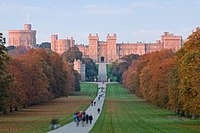File:William Essex - Francis, Duke of Saxe-Coburg-Saalfeld - Royal Collection RCIN 421648.png

Original file (564 × 738 pixels, file size: 537 KB, MIME type: image/png)
Captions
Captions
Summary edit
| Artist |
artist QS:P170,Q16065695
artist QS:P170,Q4233718,P1877,Q1694494 |
||||||||||||||||||||||||||||||||
| Description |
English: Portrait of Francis, Duke of Saxe-Coburg-Saalfeld (1750–1806)
|
||||||||||||||||||||||||||||||||
| Date |
1841 after a pastel of circa 1800 date QS:P571,+1800-00-00T00:00:00Z/9,P1480,Q5727902 |
||||||||||||||||||||||||||||||||
| Medium |
enamel on gold medium QS:P186,Q213371;P186,Q897,P518,Q861259 |
||||||||||||||||||||||||||||||||
| Dimensions |
height: 5.1 cm (2 in); width: 3.7 cm (1.4 in) dimensions QS:P2048,5.1U174728 dimensions QS:P2049,3.7U174728 |
||||||||||||||||||||||||||||||||
| Collection |
institution QS:P195,Q1459037 |
||||||||||||||||||||||||||||||||
| Inscriptions | Signed, dated and inscribed on the counter-enamel in black paint: Painted by W. Essex / 1840. / Enamel painter to Her / Majesty / after a crayon drawing. | ||||||||||||||||||||||||||||||||
| Source/Photographer | Royal Collection RCIN 421648 | ||||||||||||||||||||||||||||||||
| Other versions |
|
||||||||||||||||||||||||||||||||
Licensing edit
|
This is a faithful photographic reproduction of a two-dimensional, public domain work of art. The work of art itself is in the public domain for the following reason:
The official position taken by the Wikimedia Foundation is that "faithful reproductions of two-dimensional public domain works of art are public domain".
This photographic reproduction is therefore also considered to be in the public domain in the United States. In other jurisdictions, re-use of this content may be restricted; see Reuse of PD-Art photographs for details. | |||||
File history
Click on a date/time to view the file as it appeared at that time.
| Date/Time | Thumbnail | Dimensions | User | Comment | |
|---|---|---|---|---|---|
| current | 18:42, 8 February 2019 |  | 564 × 738 (537 KB) | ArcoCc (talk | contribs) | User created page with UploadWizard |
You cannot overwrite this file.
File usage on Commons
The following 5 pages use this file:
- File:Francis, Duke of Saxe-Coburg-Saalfeld by William Essex.png (file redirect)
- File:Johann Heinrich Schröder - Franz von Sachsen-Coburg-Saalfeld - Schloss Friedenstein.png
- File:William Essex - Francis, Duke of Saxe-Coburg-Saalfeld - Royal Collection RCIN 421648.png
- File:William Essex - Francis, Duke of Saxe-Coburg-Saalfeld - Royal Collection RCIN 422055.png
- Category:Francis, Duke of Saxe-Coburg-Saalfeld
File usage on other wikis
The following other wikis use this file:
- Usage on ar.wikipedia.org
- Usage on arz.wikipedia.org
- Usage on bg.wikipedia.org
- Usage on ca.wikipedia.org
- Usage on el.wikipedia.org
- Usage on hu.wikipedia.org
- Usage on it.wikipedia.org
- Usage on nl.wikipedia.org
- Usage on no.wikipedia.org
- Usage on ru.wikipedia.org
- Usage on sv.wikipedia.org
- Usage on vi.wikipedia.org
- Usage on www.wikidata.org
Metadata
This file contains additional information such as Exif metadata which may have been added by the digital camera, scanner, or software program used to create or digitize it. If the file has been modified from its original state, some details such as the timestamp may not fully reflect those of the original file. The timestamp is only as accurate as the clock in the camera, and it may be completely wrong.
| Horizontal resolution | 28.35 dpc |
|---|---|
| Vertical resolution | 28.35 dpc |
| File change date and time | 18:38, 8 February 2019 |


